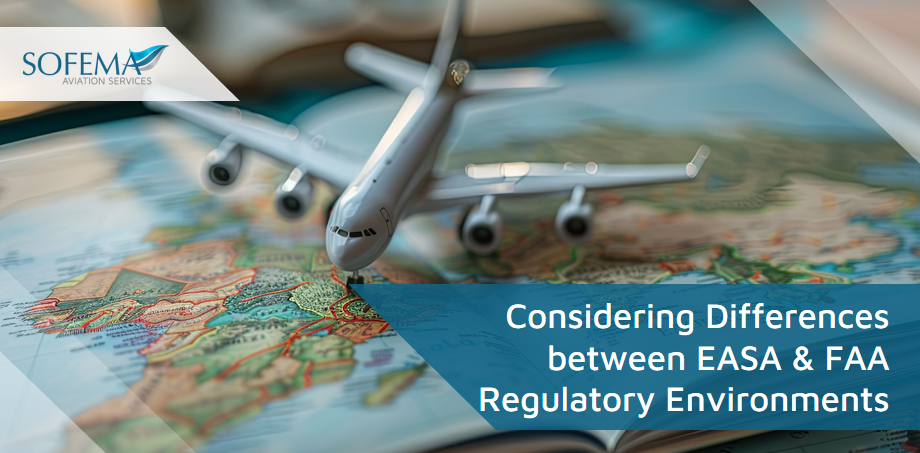EASA & FAA Regulatory Environments: Presented by Sofema Aviation Services (SAS), www.sassofia.com
Introduction
Safety Management System in Aviation – FAA vs EASA environment
- Whether we are talking about FAA or EASA as the “regulatory environment”, the focus remains on demonstrating that the organisation has an SMS that essentially shows compliance with ICAO Annex 19.
- However, if we go a little deeper we will see that there are some differences related to how organisations function, consider that EASA Quality Assurance is required to be independent and responsible for the Safety Compliance sits with the business area owners.
Commercial Air Transport (CAT) Operators SMS
- When we look at the small print, we will see that whilst SMS is clearly defined for operators (FAA Air Carrier Part 121 & EASA Air Operators Certificate holder – Air Carrier)
- What Does EASA Say for Operations SMS? – EASA has embedded compliance with ICAO Annex 19 within EASA OPS Regulation 965/2012
SMS for Part 145 Organisations
EASA has issued Commission Implementing Regulation (EU) 2021/1963 which became effective on December 2nd, 2021, and is currently at the end of transition to embed SMS within the 145 Organisation.
What Does the FAA Say for SMS? – FAA Order 8000.3698 – (This is the highest-level document) This order establishes the Safety Management System (SMS) policy for the Federal Aviation Administration (FAA) and requirements for FAA organizations incorporating SMS and/or International Civil Aviation Organization (ICAO) State Safety Program (SSP) frameworks to form the overall FAA SMS.
Specifically, this order:
- a)Furthers safety management by evolving to a more process-oriented system safety approach with an emphasis on Safety Risk Management (SRM) and Safety Assurance.
- b) Set forth basic management principles to guide the FAA in safety management and safety oversight activities.
- c)Requires adopting a common approach to implementing and maturing an integrated SMS, including fostering a positive safety culture and other attributes as applicable.
FAA Requirements for PART 121 Air Carriers – 120-92B – Safety Management Systems for Aviation Service Providers – January 08, 2015
- This advisory circular (AC) provides information for Title 14 of the Code of Federal Regulations (14 CFR) part 121 air carriers that are required to implement aviation Safety Management Systems (SMS) based on 14 CFR part 5. Specifically, this document provides a description of regulatory requirements, guidance, and methods of developing and implementing an SMS.
- This AC (120-92B) may also be used by other aviation service providers interested in voluntarily developing an SMS based on the requirements in part 5.
Considerations related to SMS in an FAA MRO Environment – Aviation Safety Management System – Voluntary Implementation of SMS for Non-Part 121 Operators, MROs, and Training Organizations.
AC 120-92B – Safety Management Systems for Aviation Service Providers.
- SMS for US Air Carries is found in FAA Requirements for PART 121 Air Carriers AC 120-92B – Safety Management Systems for Aviation Service Providers – January 08, 2015
- The FAA promotes voluntary adoption of aviation Safety Management System – for Non-Part 121 Operators, MROs, and Training Organizations again using AC 120-92B as the route for compliance (Same Document as for Part 121 Air Carriers)
Search for the following term – EASA Significant Standards Differences (SSD) between EASA and FAA airworthiness codes
- Addressing common clarifications between the European Union Aviation Safety Agency (EASA) and the Federal Aviation Administration (FAA) guidelines, along with the importance of adhering to international standards, is critical for the safety, efficiency, and legal compliance of aviation operations.
- These guidelines influence not only daily operations but also long-term strategic planning within the aviation sector. Let’s explore the challenges, best practices, and issues surrounding this topic.
Harmonization of Regulations:
- One of the main challenges concerns the differences in regulations and standards between EASA and FAA.
- Although both aim for high safety and operational standards, their approaches and requirements can differ.
- For instance, certification processes for new aircraft can vary, posing challenges for manufacturers and airlines that operate internationally.
- Rapid technological changes in aviation, such as the development of unmanned aerial vehicles (drones) and sustainable aviation fuels, require constant updates to regulations.
o Keeping international standards in sync with these advancements is a significant challenge.
- Compliance with both EASA and FAA regulations can be costly, especially for smaller operators who may lack the resources of larger airlines.
o The need to meet dual certification requirements for equipment and procedures can lead to increased operational costs.
- Regular Communication and Collaboration: Regular interaction between EASA, FAA, and other international aviation bodies helps align standards and clarify regulatory expectations. Workshops, seminars, and joint working groups are effective ways to foster collaboration.
Issues Potentially Impacting Success
- Regulatory Lag: There can be a lag in regulation updates relative to technological and operational changes. This gap can hinder the implementation of new technologies and practices that might enhance safety and efficiency.
- Resource Allocation: Insufficient resources, both financial and human, can limit the ability of regulatory bodies to enforce, monitor, and update aviation standards effectively.
- Safety vs. Innovation Trade-off: Striking a balance between maintaining rigorous safety standards and encouraging innovation can be challenging. Overly stringent regulations might stifle innovation, while an approach that is too lenient may compromise safety.
Next Steps
Follow this link to our Library to find & download related documents for Free.
Sofema Aviation Services and Sofemaonline provide EASA Compliant Webinars, Classroom, & Online training in over 50 Quality Assurance and Compliance Related Subjects – Please see the websites or email team@sassofia.com.
Tags:
aviation safety, Aviation Training, Safety Management System, Regulatory Compliance, EASA regulations, FAA Regulations, SAS blogs, Aircraft Certification, EASA Part 145 SMS, SMS Compliance, aviation standards, Aviation Safety Culture, Aviation Innovation, Aviation Workshops





